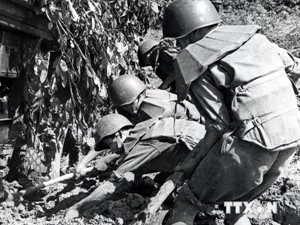Former VOV reporter Le Thong remembers the day he arrived at the Truong Son Trail in 1972. The two things that impressed him most were the dramatic atmosphere there with soldiers marching and supply trucks running day and night along the trail, and the soldiers’ iron will and endurance to overcome difficulties for national salvation. What kept the soldiers’ spirits up were their little pocket radios on which they listened to VOV broadcasts with music and news from home. One of the many moving stories Thong reported in his 3 years on Truong Son trail concerned a young volunteer who always kept his radio by his side. After he was killed, his body was located by his comrades thanks to his radio, which was still playing a VOV broadcast.
"The soldiers considered VOV their close friend and a lifeline connecting them with the world. VOV’s broadcasts brought them news and entertained them with music," said Thong.
Tran Duc Nuoi, another VOV reporter, says 4 VOV war correspondents led by Mr. Vu Duong were among the first to traverse the Truong Son trail through Vietnam’s southeastern region. Nuoi arrived at Truong Son in October, 1974 and passed through some of the fiercest battlefields along the trail, including A Sau, A Luoi, and the western portions of Thua Thien Hue province.
 Vietnamese soldiers on the Truong Son Trail. (Photo: VNA) Vietnamese soldiers on the Truong Son Trail. (Photo: VNA) |
"The Voice of Vietnam was the only communications channel at that time for on-duty soldiers. Newspapers were available but only once every month and were very hard to get. Broadcasts by VOV and Liberation Radio were the two most important sources of information for the soldiers, who faced numerous hardships, even death, while marching along the trail. Those broadcasts helped ease their homesickness and the pain of their wounds, cheered them up with music, and encouraged them to fulfill their mission to reunify the country," Nuoi told VOV.
VOV sent many musicians to the combat zone to entertain the soldiers and volunteers working on the trail. Revolutionary songs like “The red leaves”, “East and West of Truong Son”, and “The Hanoi song”, unified the soldiers, fortified their spirits, eased the weariness of marching, and encouraged them to complete their tasks. People’s Artist Thanh Hoa performed for soldiers on the Truong Son trail in 1974. She said it was a privilege to sing for the soldiers.
"The moment I arrived at the Truong Son trail, all I could think of was what I could do for national liberation and independence, even if I had to sacrifice my life. The trail was created with the blood and sweat of many, many soldiers with a strong will and desire to fight for freedom. The trail is a symbol of national patriotism and pride," singer Thanh Hoa recalled.